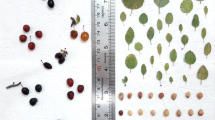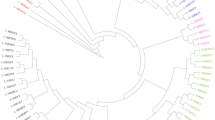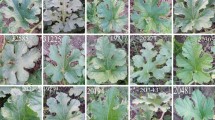Abstract
Knowledge of relationships among the cultivated and wild species of Cerasus, a subgenus of Prunus L., is important for recognizing gene pools, identifying pitfalls in germplasm collections and developing effective conservation and management strategies. In this study, morphological characterization of wild Cerasus subgenus species naturally growing in Iran, including P. avium L. (mazzard), P. mahaleb L., P. brachypetala Boiss., P. incana Pall., P. yazdiana Mozaff., P. microcarpa Boiss. subsp. microcarpa, P. microcarpa Boiss. subsp. diffusa and P. pseudoprostrata Pojark. and three commercial species, sweet cherry (P. avium L.), sour cherry (P. cerasus L.) and duke cherry (P. × gondouinii Rehd.) was investigated. Twenty-nine variables were recorded in 95 accessions of these species to detect similarities among them. All studied characteristics were showing a high degree of variability, but it was highly pronounced for plant height, leaf characters especially for dimensions and pubescence as well as for petiole and peduncle length. The majority of significant correlation coefficients were found in the characteristics representing plant size and growth habit with leaf size. Principal component analysis was performed for phenotypical diversity determination and grouping of species. Characters with high discriminating values were those related to growth habit, height, compactness, trunk diameter, leaf dimensions, petiole length, leaf tip and serration, flower color, peduncle length, fruit shape and stone shape. Based on the cluster analysis, species included in two main clusters, first those with large structure (sweet, sour and duke cherries, mazzard and mahaleb), second the other species with small structure which might be potentially suitable for rootstock breeding programs. Scatter plot using two first factors also confirmed the grouping by cluster analysis. The conservation of the highly diverse native populations of Iranian wild Cerasus species is recommended.





Similar content being viewed by others
References
Badenes ML, Martinez-Calvo J, Llacer G (1998) Analysis of apricot germplasm from the European ecogeographical group. Euphytica 102:93–99
Badenes ML, Martinez-Calvo J, Llacer G (2000) Analysis of a germplasm collection of loquat (Eriobotrya japonica Lindl.). Euphytica 114:187–194
Balmer M, Blanke M (2005) Developments in high density cherries in Germany. Acta Hort 667:273–278
Beyer M, Hahn R, Peschel S, Harz M, Knoche M (2002) Analysing fruit shape in sweet cherry (Prunus avium L.). Sci Hortic 96:139–150
Brown SK (1988) Assessment of fruit firmness in selected sour cherry genotypes. HortScience 23:882–884
Cantini C, Cimato A, Sani G (1999) Morphological evaluation of olive germplasm present in Tuscany region. Euphytica 109:173–181
Charlot G, Edin M, Flochlay F, Soing P, Boland C (2005) Tabel® Edabriz: a dwarf rootstock for intensive cherry orchards. Acta Hort 667:217–222
Christensen JV (1970) Numerical studies of morphological distinction marks in sweet cherry cultivars, identification key for 34 cultivars. Tidsskr Planteavl 74:44–74
De Nettancourt D (2001) Incompatibility and incongruity in wild and cultivated plants, 2nd edn. Springer, Berlin
Demirsoy H, Demirsoy L (2004) A study on the relationships between some fruit characteristics in cherries. Fruits 59:219–223
Esti M, Messia MC, Sinesio F, Nicotra A, Conte L (1997) Quality evaluation of peaches and nectarines by electrochemical and multivariate analyses: relationships between analytical measurements and sensory attributes. Food Chem 60:659–666
Faust M, Zagaja SW (1984) Prospects for developing low vigor fruit tree cultivars. Acta Hortic 146:21–27
Ganji Moghadam E, Khalighi A (2007) Relationship between vigor of Iranian Prunus mahaleb L. selected dwarf rootstocks and some morphological characters. Sci Hortic 111:209–212
Hammer Ø, Harper DAT, Ryan PD (2001) PAST: paleontological statistics software package for education and data analysis. Palaeontologia Electronica 4(1):9. http://palaeo-electronica.org/2001_1/past/issue1_01.htm
Hedrick UP (1915) The history of cultivated cherries. In: Hedrick UP (ed) The Cherries of New York. JB Lyon, Albany
Hillig KW, Iezzoni AF (1988) Multivariate analysis of a sour cherry germplasm collection. J Am Soc Hortic Sci 113:928–934
Hjalmarsson I, Ortiz R (2000) In situ and ex situ assessment of morphological and fruit variation in Scandinavian sweet cherry. Sci Hortic 85:37–49
Horvath A, Christmann H, Laigret F (2008) Genetic diversity and relationships among Prunus cerasifera (cherry plum) clones. Botany 86:1311–1318
Hrotko K, Magyar L, Gyeviki M (2008) Evaluation of native hybrids of Prunus fruticosa Pall. as cherry interstocks. Acta Agri Serbica 13:41–45
Iezzoni AF (2008) Cherries. In: Hancock JF (ed) Temperate fruit crop breeding. Springer, Berlin, pp 151–175
Iezzoni AF, Pritts MP (1991) Applications of principal components analysis to horticultural research. HortScience 26:334–338
Ingram C (1948) Ornamental cherries. Country Life Limited, London
Khadivi-Khub A, Jaffari H, Zamani Z, Fatahi R (2010) Morphological characterization of some sweet, sour and duke cherry genotypes. In: Proceedings of the 28th international horticultural congress, Lisboa, Portugal, 22–27 August
Koehne E (1912) Prunus L subgen. Cerasus. In: Sargent CS (ed) Plantae Wilsonianae, vol 1. Harvard University Press, Massachusetts, pp 226–262
Krahl KH, Lansari A, Iezzoni AF (1991) Morphological variation within a sour cherry collection. Euphytica 52:47–55
Krussmann G (1978) Prunus. In: Daniels GS (ed) Manual of cultivated broad-leaved trees and shrubs, vol 3. Timber Press, Portland, pp 18–58
Magyar L, Hrotko K (2008) Prunus cerasus and Prunus fruticosa as interstocks for sweet cherry trees. Acta Hort 795:287–292
Martinez-Calvo J, Gisbert AD, Alamar MC, Hernandorena R, Romero C, Llacer G, Badenes ML (2008) Study of a germplasm collection of loquat (Eriobotrya japonica Lindl.) by multivariate analysis. Genet Resour Crop Evol 55:695–703
Mozaffarian V (2004) Trees and shrubs of Iran. Farhang Moaser, Tehran, pp 665–676 (In Farsi)
Nikolic D, Rakonjac V, Milatovic D, Fotiric M (2010) Multivariate analysis of vineyard peach [Prunus persica (L.) Batsch.] germplasm collection. Euphytica 171:227–234
Ohba H (1992) Japanese cherry trees under the genus Cerasus (Rosaceae). J Jpn Bot 67:276–281
Ohba H (2001) Cerasus. In: Iwatsuki K, Boufford DE, Ohba H (eds) Flora of Japan volume IIb angiospermae dicotyledoneae archichlamydeae (b). Kodansya, Tokyo, pp 128–144
Ohwi J (1965) Prunus. In: Meyer FG, Walker EH (eds) Flora of Japan. Smithsonian Institution, Washington, pp 541–545
Perez S, Montes S, Mejia C (1993) Analysis of peach germplasm in Mexico. J Am Soc Hortic Sci 118:519–524
Perez-Sanchez R, Gomez-Sanchez MA, Morales-Corts R (2008) Agromorphological characterization of traditional Spanish sweet cherry (Prunus avium L.), sour cherry (Prunus cerasus L.) and duke cherry (Prunus × gondouinii Rehd.) cultivars. Span J Agri Res 6:42–55
Rakonjac V, Fotiric Aksic M, Nikolic D, Milatovic D, Colic S (2010) Morphological characterization of ‘Oblacinska’ sour cherry by multivariate analysis. Sci Hortic 125:679–684
Rehder A (1940) Manual of cultivated trees and shrubs hardy in North America exclusive for subtropical and warmer temperate regions, 2nd edn. Macmillan, New York
Robertson KR (1974) The genera of Rosaceae in the southeastern United States the Arnold. Arboretum 55:654–662
Rodrigues LC, Morales MR, Fernandes AJB, Ortiz JM (2008) Morphological characterization of sweet and sour cherry cultivars in a germplasm bank at Portugal. Genet Resour Crop Evol 55:593–601
Roper TR, Loescher WH (1987) Relationship between leaf area per fruit and fruit quality in ‘Bing’ sweet cherry. HortScience 22:1273–1276
Ruiz D, Egea J (2008) Phenotypic diversity and relationships of fruit quality traits in apricot (Prunus armeniaca L.) germplasm. Euphytica 163:143–158
Shahi-Gharahlar A, Zamani Z, Fatahi MR, Bouzari N (2010) Assessment of morphological variation between some Cerasus genotypes. Hort Environ Biotechnol 51:308–318
Suzuki H, Egashira H, Yamada T, Fujita M, Ogasawara N (2006) Interspecific crossing between sweet cherry (Prunus avium L.) and ornamental cherry (Prunus × yedoensis Matsum.). Hort Res (Japan) 5:343–349
Taiz L, Zeiger E (2002) Plant Physiology, 3rd edn. Sinauer Associates, Sunderland
Tavaud M, Zanetto A, David JL, Laigret F, Dirlewanger E (2004) Genetic relationships between diploid and allotetraploid cherry species (Prunus avium, Prunus × gondouinii and Prunus cerasus). Heredity 93:631–638
Theiler-Hedtrich R (1990) Relationships between fruit weight and diameter in cherries. Schweiz Z Obst Weinbau 126:590–598
Webster AD, Looney NE (1996) Cherries: crop physiology and uses. CAB International Cambridge University Press, United Kingdom
Wu B, Quilot B, Kervella J, Genard M, Li S (2003) Analysis of genotypic variation of sugar and acid contents in peaches and nectarines through the principle component analysis. Euphytica 132:375–384
Author information
Authors and Affiliations
Corresponding author
Rights and permissions
About this article
Cite this article
Khadivi-Khub, A., Zamani, Z. & Fatahi, M.R. Multivariate analysis of Prunus subgen. Cerasus germplasm in Iran using morphological variables. Genet Resour Crop Evol 59, 909–926 (2012). https://doi.org/10.1007/s10722-011-9733-2
Received:
Accepted:
Published:
Issue Date:
DOI: https://doi.org/10.1007/s10722-011-9733-2




